Are you planning to start a blog soon? If so, you’re in for a treat!
Blogging is a fun and rewarding hobby. It is one of the best ways to share your thoughts and ideas with the world. But what most people don’t know is that through blogging, you can also make some money on the side. Yes, you can actually earn money by writing blogs!
In this step-by-step guide, I will discuss everything you need to know about starting a blog. I’ll cover topics such as identifying your blog niche, picking a name for your blog, and choosing a blogging platform. I’ll also tackle blog hosting, blog theme and appearance, and many more! By the end of this guide, you will have all the information you need to get started on your blogging journey.
So, whether you’re a complete beginner or just looking for some tips and advice, read on!
Want to save this post for later? Pin the image below!
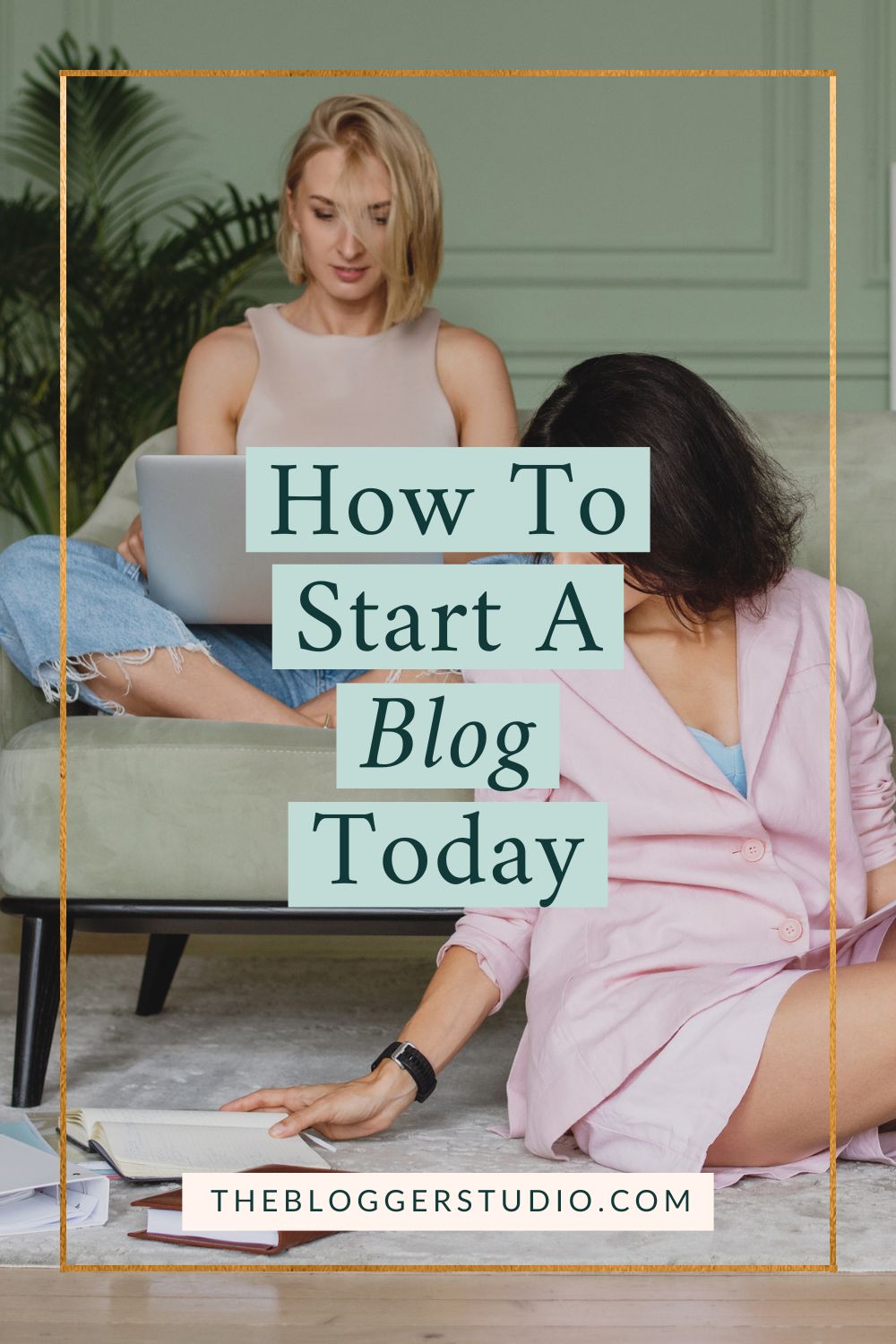
Affiliate Disclosure: This page contains affiliate links which means that if you click on the link and purchase the item, I will receive an affiliate commission at no extra cost to you which I will then use to maintain this blog. See my full disclosure policy here.
WHY SHOULD YOU START A BLOG?
For you to have a successful blog, it will take a huge amount of time and commitment. However, it can also be profitable and extremely rewarding.
If you are willing to put in some extra effort, you might gain more out of your blog than you expect. That said, here are some of the reasons you may want to start a blog today.
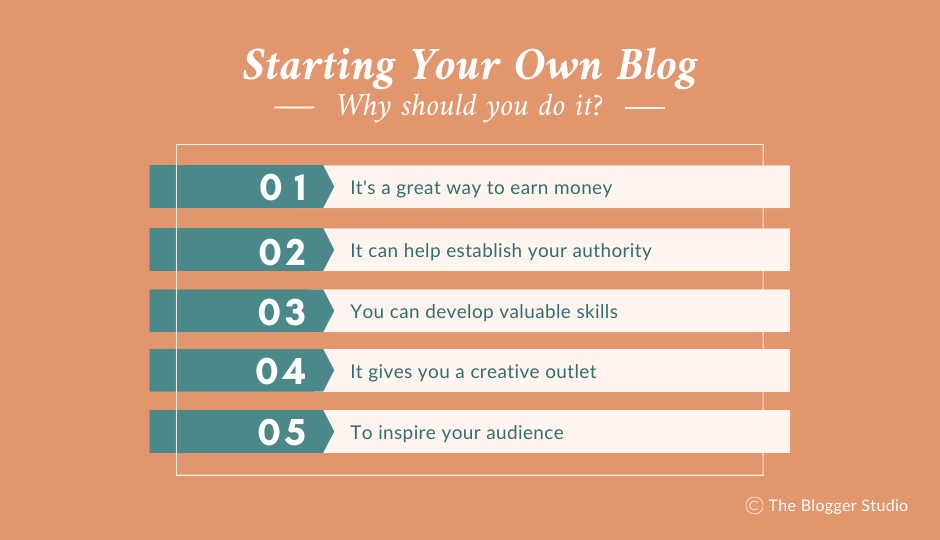
Start a blog to make money online
Nowadays, there are many ways to make money online but I can say that blogging is definitely one of the best, whether that’s directly or indirectly. Your blog can bring in good money depending on a number of factors, including how much traffic your site receives and how you choose to monetize it.
For example, some bloggers sell their own physical or digital products, offer coaching services, or do affiliate marketing.
If you do things right, you can earn thousands per month from a single blog, or even make blogging your full-time career just like a number of successful bloggers have.
It can help you establish authority
Do you want to establish yourself as an expert with authority in your field? Blogging is the key! You will find that starting a blog is extremely beneficial if you are running a business or are a professional searching for more clients.
The more your name gains recognition through your blog, the more chances you can have of gaining connections and customers.
Start a blog to develop some valuable skills
Blogging can help you to improve some valuable skills that will benefit you in both your personal and professional life. The first (and most obvious) is writing. If you don’t think of yourself as a great writer, that’s okay! I used to be like you too.
But trust me when I say that starting a blog has helped me improve my writing skills because the more I blog, the more I’m able to organize my thoughts and develop an engaging story.
Another skill you can learn is coding. This is not to say you’ll become a Software Developer after a couple of years of blogging but I mean you’ll learn basic HTML and CSS that will help you make adjustments on your blog without the need for an expert.
Last but not least, you’ll also likely find yourself becoming more organized and observant in everyday life. All of these skills can help you in many ways you can think of.
Related Post: “Are Blogs Still a Thing?”
HOW TO START A BLOG: A STEP-BY-STEP GUIDE
STEP 1: Identify your Blog Niche
Unless you are a successful journalist or a popular actress who is able to draw tons of readers by your reputation alone, your blog is going to need a theme. What’s more, if you really want to make money from your blog, your niche must have some potential for profit. This means choosing a topic that a substantial number of people are also interested in.
Related Post: “The Best Blog Niche Ideas (that actually make money)“
Picking the right niche will help make creating your blog both enjoyable and profitable, but the question remains: how do you decide on the right niche?
The first is to choose content that provides value. There are literally millions of blogs online, why should people read yours? Again, unless you are someone very famous, readers may not care about your vacation in Bali or share your love for cheese. Unless he’s a personal friend, he may not care about the recent gadget you bought. That means you’re going to have to pick a subject that will benefit your readers and stick with it.
Another tip is to pick a topic you sincerely care about. Remember that in order to be successful in blogging, you’re going to be writing regularly for a long time. If you’re not personally interested in your topic, your content will become dry and boring really fast. Who would want to read that?
Finally, choose a niche that’s the right size. If you pick something too general, your blog may be lost in a sea of search results. Likewise, if you choose more than one niche for your blog, you may lose your focus just like how I lost mine when many years ago I decided to blog about anything under the sun.

Remember though that you can tweak your niche a bit as you build your blog. You can decide to make it more specific if you feel you started with too wide of a focus. Conversely, you can still add a variety of blog posts to broaden your subject if you realize your niche is too small.
Overall, if you do your research and choose something that you and your target readers are passionate about, your niche is most likely to help make your blog successful.
STEP 2: Pick a Name for your Blog
If you don’t have a blog name yet, this is the best time to think about it. The key is to aim for something that is interesting and unique, yet catchy and descriptive at the same time. There are two big factors you have to consider when making this decision: SEO and Branding.
SEO is search engine optimization – in other words, setting up and tweaking your website to ensure that it will likely show up in top searches and rank highly on Google. In some ways, your URL can affect your SEO because some URLs are more ‘searchable’ than others.
Let me give you an example. When you type ‘bodybuilding’ on the Google search bar, you will see that https://www.bodybuilding.com is the top result.

Please keep in mind though that this won’t guarantee you’ll rank higher in the search results. Obviously, bloggers who have done more work at their SEO could still beat you in other ways. This is just a good head-start and advantage.
Another factor is branding. The name that you choose will establish your brand. It will be the name that people remember, and it will be with you forever. Other bloggers choose their own name as their blog name, especially those who are establishing themselves as a brand. However, if you choose to incorporate a bit of SEO into your branding, at least make it more memorable and interesting.
So let’s say you want to start a blog about vegan recipes, ‘veganrecipes.com’ would be a dull URL that’s not great for branding. Much better would be something like Veggieful, Simple Vegenista, or The Minimalist Vegan. This is easier for creating logos, making an impression, and more but it will still give you some SEO benefits and won’t be too obtuse.
STEP 3: Choose a Blogging Platform
You can start a blog for free through a number of free platforms available, but take note that most
free hosts will not allow advertising, so this means you will not be able to generate a stream of income from ad clicks and sales.
For example, you can create a blog through WordPress.com for free but you won’t be able to monetize it at all, whereas WordPress.org will not only allow you to monetize your blog but will also enable you to customize your website through a variety of plugins and themes.
Having said that, WordPress.org will always be my number one choice. WordPress makes it easy to upload images, create categories, and it also works well in different browsers. It may also have some SEO benefits since each posting can be tagged easily and hence searched by the search engines. On top of that, it’s pretty easy to set up as well. You can find the instructions here.
If you would like to explore other options, here are some popular blogging platforms you can look at as well: Blogger, Wix.com, Tumblr, and Typepad.
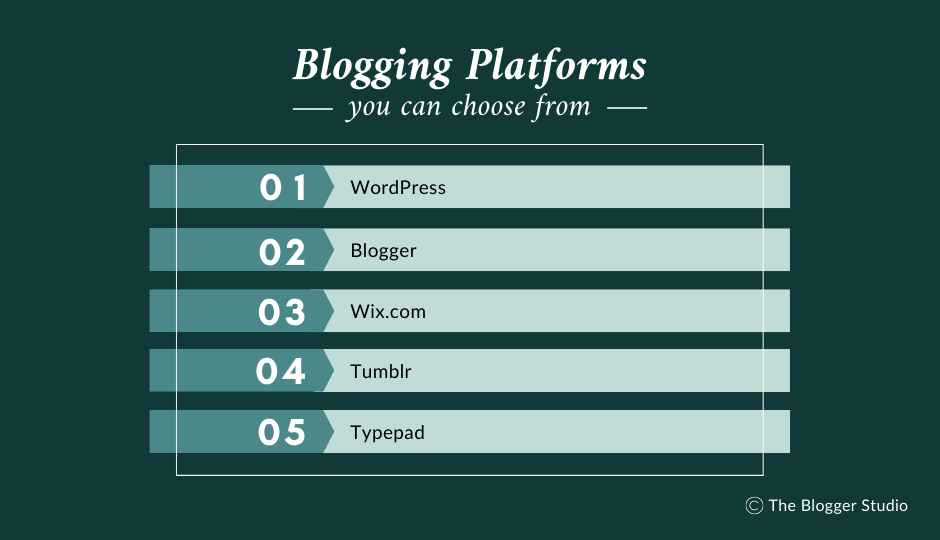
STEP 4: Get Blog Hosting
Unless you don’t want to make money from your blog or if you want your blog URL to look something like ‘myawesomeblog.wordpress.com’, you will need to purchase a domain name and web hosting services from a reliable web host.
The most popular ones among many successful bloggers are Siteground and Bluehost. Personally, I’ve used Siteground before and truly recommend it, but between you and me, a much more affordable yet effective option is Hostinger.
For as low as $2.99 a month, you get unmetered traffic for a maximum of 100 websites, free weekly backups, a free email, and a free domain for one year! What’s more, they have amazing 24/7 customer service so there’s no need to worry if you need assistance along the way. Honestly, I wish I’d known about Hostinger when I first started blogging. I would have saved so much money!
Below are other hosting plan features you can enjoy if you choose Hostinger as your web host. If you want to learn more about what they can offer as well as the pricing, click here.

Pro Tip: Always go for the longest hosting plan. It will save you heaps more than having to renew again after a year and paying a higher renewal fee. Trust me, I made this mistake a couple of times.
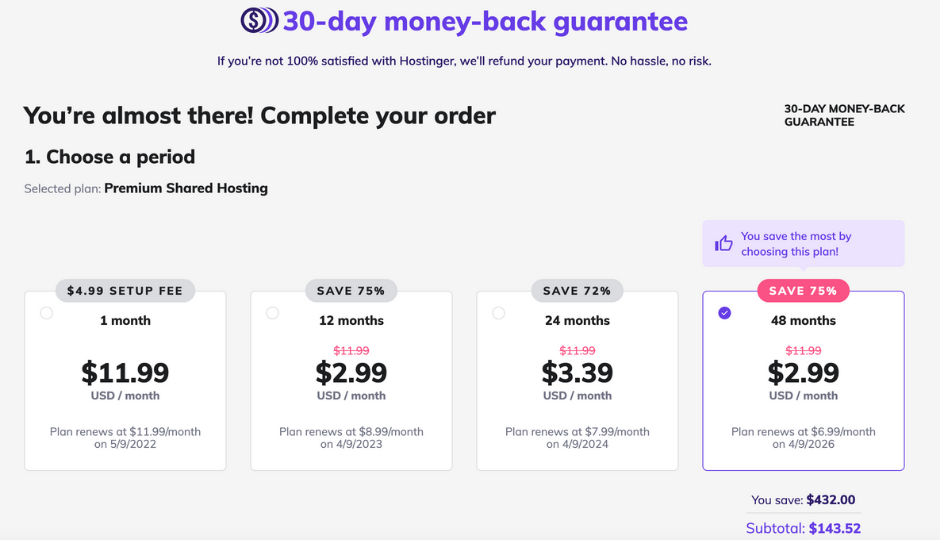
STEP 5: Install WordPress
You’ll find it very easy to install WordPress on Hostinger. All you have to do is to access the control panel > open the Auto Installer > search for WordPress > fill in your website details > press the Install button. You can read the full tutorial here.
STEP 6: Set Up Your Blog’s Theme and Appearance
Now that you have your blog URL and you have installed WordPress, you are ready to start creating. The first thing to do? Decide on the design you want to use!
Here are the elements you need to think about when designing your blog’s appearance:
Logo
Your logo is a critical part of your branding and chances are your website design will be heavily inspired by it. Your website theme will most likely incorporate the colors from your logo and use certain visual cues which will help create a consistent design language for your entire blog.
It’s a great starting point and it will make establishing your design much easier.
When coming up with your logo, it is important to recognize the following criteria: simplicity, versatility, suitability, and originality.
Since you are going to be using your logo in various places throughout your online presence, it needs to be simple and versatile. This means your logo has to always look its best whether it’s on your website or social media accounts. Try creating different versions and remember to make it simple.
Moreover, your logo should be suitable for your blog and communicate your message well. The type of website you will be building will determine whether your logo should look professional, fun, or colorful.
Finally, in terms of originality, avoid the obvious clichés such as lightbulbs and globes in your logo. These are so overused and will make your entire brand look below average.

Having said the above, I highly recommend using Adobe Illustrator for your logo if you have the budget. If not, Canva works perfectly as well and you can easily use it not only for your logo but for all your blog graphic needs.
Theme
Now that you have created your amazing logo, you can start thinking about the artistic direction of your website. By that, I mean choosing the right theme that will suit your blog.
There are a few things to keep in mind when picking a website theme. You have to make sure that:
– Your theme is responsive and looks great on any sized display
– It’s quick to load
– It must be optimized for mobile
– It should be simple and easy to navigate
– The theme looks professional and pleasing to the eyes
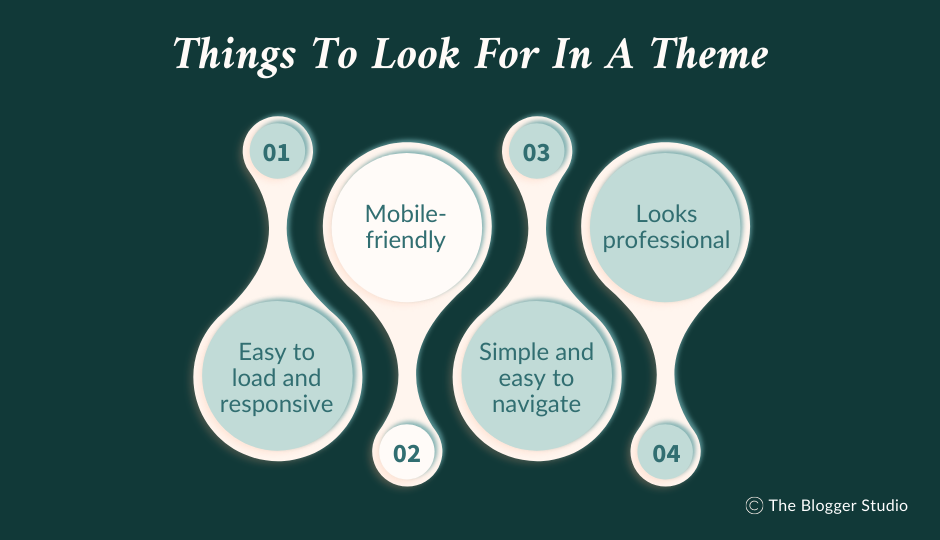
You can find free themes right through WordPress, however, the problem with them is that they tend to have fewer options and look less professional than paid themes. At the same time, there’s always a chance of someone else having the exact same WordPress theme as yours and this will make your brand identity look less unique.
That said, it might be better to search for premium WordPress themes by looking from sites such as Creative Market, Envato, or Etsy, or you can hire a designer to create a custom theme for your blog. While the latter option is the best way to get a theme that will perfectly match your branding and requirements, it can obviously be more expensive. So if you are just starting your first blog, there are lots of gorgeous yet effective pre-made WordPress themes that you can choose from online.
If you are torn between themes, you can try looking at some of the blogs you admire and enjoy. What type of layout do they have? What are the positives and the negatives? By looking at different websites, it will ensure you won’t be wasting your precious time working with a doomed blog theme.
Widgets
These are the small forms, sidebars, and other elements that provide different functions on your blog. Some examples of widgets are the ‘opt-in’ forms for mailing lists, feeds from social media, advertising slots, etc. and these are a great way to give your site more features for your readers.
Fonts
When I started my first blog, I used smaller fonts for my content and even used the color gray for the majority of my articles. I thought it looked great at first but then I later realized it looked ridiculous and unreadable. In saying that, make sure that the typefaces and fonts you use within your blog not only complement your website theme and brand identity but also make your content easy to read.
Color Palette
Coming up with a color scheme for your new blog is one of the most enjoyable tasks you can do. However, it is also a critical element that will affect the overall feel of your website.
A great strategy is to choose colors that will evoke specific feelings in your readers. This is called color psychology and it can have either a positive or negative effect on every single visitor to your website so make sure to pick carefully! You can use the image below as your guide.
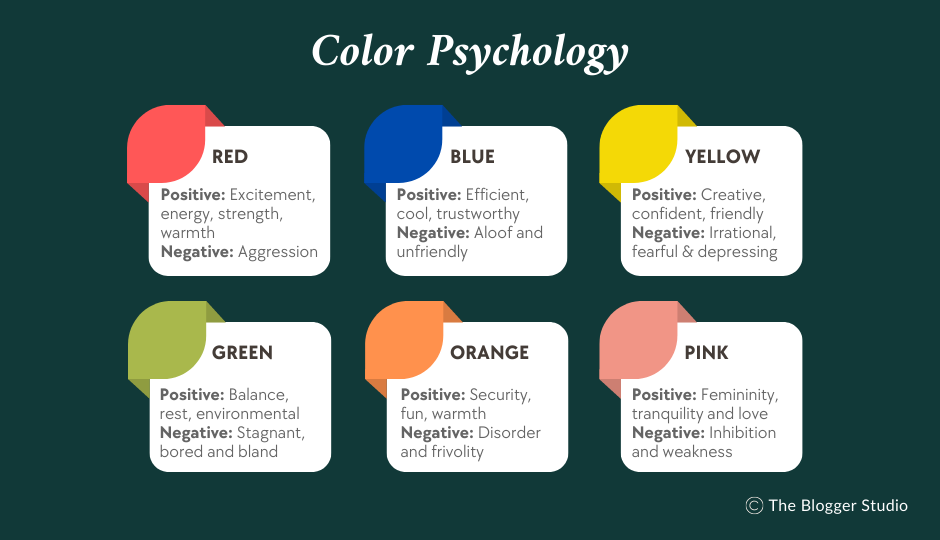
STEP 7: Install Plugins
In order to add functionality to your website, you will need to install plugins. There are many options to choose from but below are some of the essential ones which you can install for free.
– Yoast SEO: This will help improve your content’s readability and your site’s SEO.
– Elementor: A website builder that will help customize your blog using drag and drop widgets. This is perfect for users who don’t have any coding experience or a budget to hire a developer.
– Akismet: This will help get rid of spam comments from your site.

You can find more free WordPress plugins here.
STEP 8: Set Up Your Menus and Pages
When you start a blog, the menus and pages are entirely up to you as this will depend on the type of website you are building. It also depends on the theme that you have purchased.
For example, with my theme, I’m able to have a Primary Menu which is the main menu usually found below or beside the site’s logo, a Secondary Menu that contains my ‘Home’ and ‘About’ pages, and the Footer Menu which includes my categories and legal pages. The Primary and the Footer Menus are typically in every theme but not all may have a Secondary Menu.
In terms of the pages, below are the most important ones that every blogger should have when starting a blog:
About Page
This page is essential as it gives you the chance to introduce yourself to your audience and let them know what they should expect from your blog. Consider this as an opportunity to showcase yourself and your personality so that your readers can trust you more and consider you a credible source of information.
Related Post: “How To Monetize Your About Page”
Contact Page
Now that you have introduced yourself, it’s time to let your readers know how they can get in touch with you. The easiest way to do this is to create a contact form using a plugin called WPForms.
While it is recommended to have a contact form, you can also simply write a short paragraph including your blog email address. Easy-peasy, right?
Legal Pages
When I decided to start a blog for the first time, I honestly didn’t think about the legalities involved. I just thought blogging was as simple as writing and creating stuff for your readers and that’s it. Good thing it didn’t take long for me to discover that protecting myself legally is one of the most important aspects of building a successful blog.
According to Lucrezia Iapachino from Blogging for New Bloggers, the most critical ones are privacy policy, disclaimer, terms & conditions, and disclosure.
Now if you are thinking, ‘where can I find templates for those?’, search no more! Lucrezia is a lawyer too and she offers the best legal templates online. You can purchase all of these templates separately or if you want to save a lot of money, I suggest buying this bundle instead.

Once you have all the necessary pages and menus set up, it’s time to create your first blog post!
STEP 9: Start Creating Content
When people search for things on Google, they want information, opinion, or entertainment. So you’re going to need to add content if you want to start growing your visitors and building momentum for your blog. By adding more content to your blog, you give readers more incentive to visit and at the same time, you also have the chance to get to know them as your audience.
Related Post: “Proven Content Creation Tips You Should Know About”
So how much content should you be adding?
Honestly, there’s no single answer here as it will highly depend on what your blog is about, who your audience is, what your SEO strategy is, etc. Aside from that, you also have to keep in mind that quality always trumps quantity. You can write as much content as you want but if none of them provides value to your readers, no one will be interested in reading them.
BUT the basic guideline for how many blog posts you should be adding is: as many as you possibly can while staying consistent.
Indeed, consistency is key.
To start a blog and make money from it, you need to really invest yourself in it. This means spending a lot of your time creating great quality content that your readers will enjoy. You can decide to post once or twice a week but you have to do it consistently. Your rewards will grow exponentially the more top-quality content you are putting out.
How long should each blog post be?
Your blog post should contain at least 300 words but if you want better chances of ranking in search engines, it would be best if you write long-form blog posts meaning it should have 1,000 words or more.
How do you choose a topic for your blog posts?
The next question you have to think about is how will you pick topics for your blog. How will you bring something fresh and unique to your chosen niche? How will you ensure that your blog posts are in demand and are going to attract a lot of readers? Below are some tips:
– Write a subject that people are actually searching for on Google but do not show a lot of results yet. This means there is less competition in that subject.
– Look at forums, news sites, and blogs to see what other people are talking about.
Once you have chosen a topic, it’s time to create some posts!
STEP 10: Monetize Your Blog
Now that you know how to start a blog, it’s time for the fun part…. it’s time to start bringing in some cash!
There are many ways to do this but below are the common ones:
Creating and selling your own products
The best way to make money from a blog is to sell products. It could be physical products like travel gear or skin care essentials, or it could be informational products like digital courses or e-books.
I personally prefer digital products as they have no overheads or delivery costs.
Advertising
Putting ads on posts is also a great way to make money from a blog. As a beginner blogger, you can start by signing up for Google AdSense to start earning money immediately.
Take note though, that you’re only going to make a few cents per click from
those ads. If you ask me, I would wait until I get thousands of views per day and sign up for better ad companies such as Mediavine. Until then, I would search for other options such as selling products or affiliate marketing.
Affiliate Marketing
If you’d rather not have any ads or sell your own products, you can instead sell someone else’s product for a commission. This is my favorite way to make money from a blog because it gives me a much wider selection of things to sell which means I can pick products that are already successful.
Essentially, with affiliate marketing, you’ll be given your own affiliate links to promote and every time someone clicks on those links and buys a product, you get a commission. A great strategy is to put those links in your blog post in a form of a review or a list of ‘key resources’.
There are many more ways to monetize your blog but the ones above are the most recommended.
Related Post: “How To Make Money Off A Blog”
CONCLUSION
So there you have it! You’re on your way to becoming a professional blogger! Just put in the work and eventually, you will gain enough readers and start making a lot of money from your blog.
If success doesn’t come at first, don’t lose hope! It WILL take time. But in the end, it will be all worth it.
Choose a PIN to share!
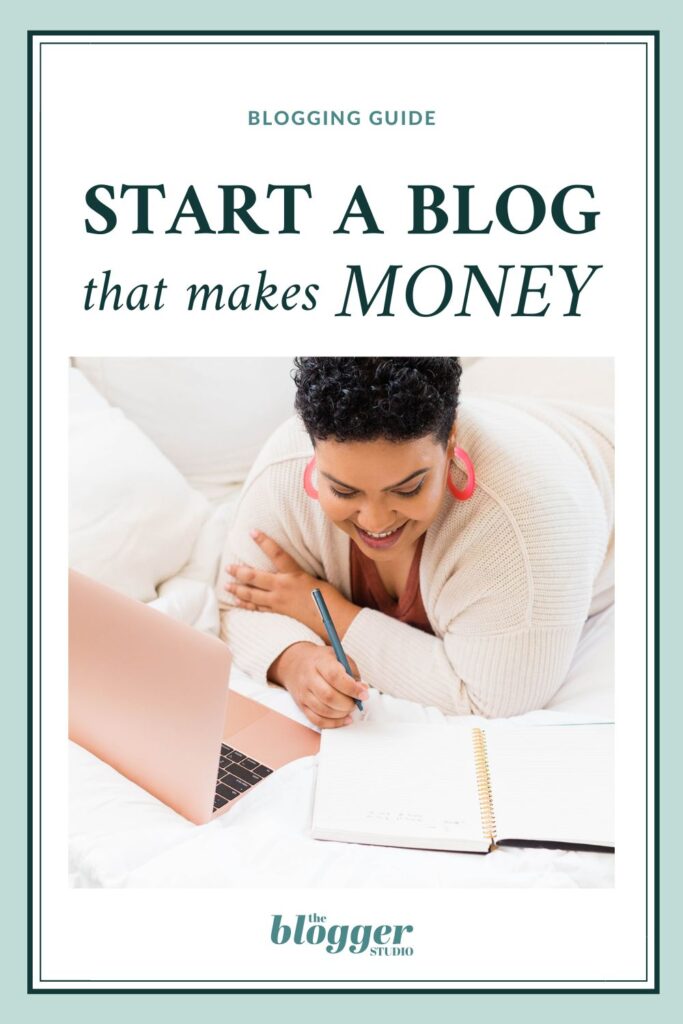
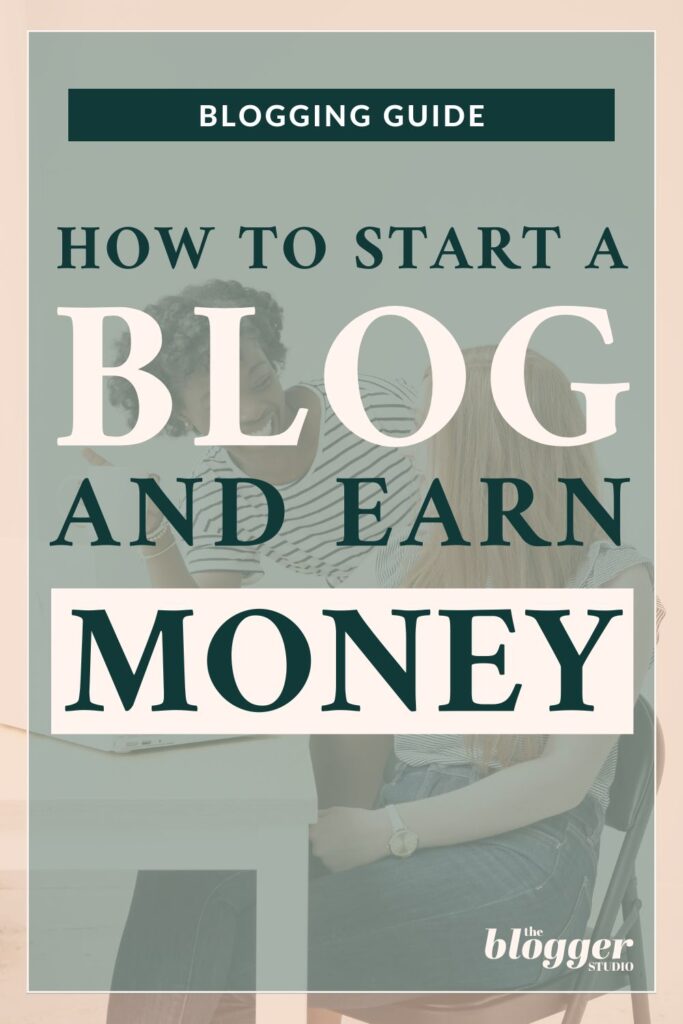


0 Comments